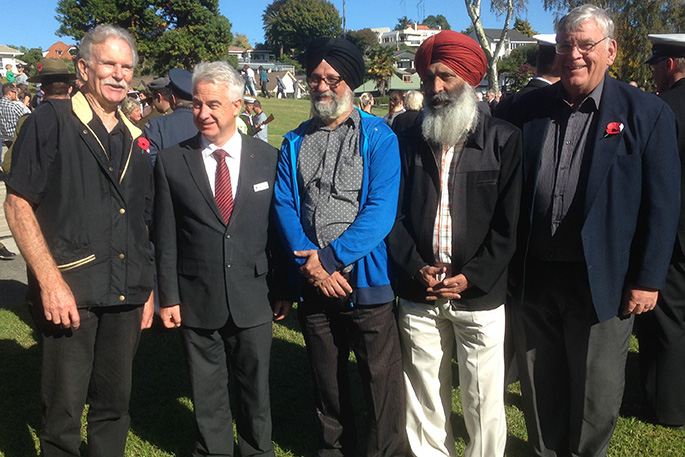Members of Tauranga's Sikh community attended their first Anzac ceremony on Tuesday, after being invited along by Deputy Mayor Kelvin Clout.
The idea came about from local resident Chris Archer, who discovered the Sikh participation in Gallipoli while doing some research on the New Zealand Mounted Rifles.
'In the process I kept encountering these interesting people called Sikhs,” says Chris.
'I knew we had a strong Sikh community here in Tauranga, and I was impressed to find they were heavily involved in all aspects of the First World War, but they were also at Gallipoli.
'So I said to Kelvin, we need to get them involved in Anzac Day, as they might not automatically go to such a day.”
Chris shared what he knew about the Sikh role at Gallipoli – including the fact that around 5000 of them served – before the deputy mayor suggested they come along and take part on April 25.
Tauranga Sikh Temple president Puran Singh says it was the first he had ever been to an Anzac Day ceremony.
'We were very appreciative. Next time we will all be going. We like it.”
Mayor Greg Brownless says Anzac Day has always been open to everybody.
'But this is probably the first time we had Sikhs attending in light of their involvement in the campaign. So I met them afterwards and had a chat.
'The key thing for me is that as many people as possible come along. That being said, it would appear Anzac Day is gaining more support every year.
'I attended the dawn service at Mount Maunganui, which was very special. There were crowds so big I couldn't even guess how many were there.”
SIKHS AT GALLIPOLI
Throughout the Gallipoli campaign Sikhs from the British Army of India served alongside Anzac soldiers in the trenches and on the slopes of Gallipoli.
Approximately 5000 Sikhs were present and an estimated 1400 were killed.
The Sikh mule corps transported supplies and ammunition to the front line by night in order to avoid the dangers of Turkish sniper fire. They often supported the Anzac troops as the 14th Sikh Infantry Regiment and during the third battle of Krithia, in Gully Ravine on June 4, 1915, they unleashed repeated attacks against Turkish machine guns and barbed wire, never retreating in the face of the enemy. In one day the 14th Sikhs lost 379 officers and men killed which represented 82 per cent of those engaged in the fighting.
They later earned a special commendation from the Commanding General Sir Ian Hamilton who greatly admired their courage and dependability.
After Gallipoli, the Sikh and Gurkha regiments fought in Egypt, Palestine and Mesopotamia. During the course of WW1 India sent more than 1.3 million men to fight in the British Army, losing nearly 80,000 men.
Of the 22 Military Crosses awarded to Indian troops during the First World War, the Sikhs won 14 of them.



1 comment
Nice thoughtfull touch
Posted on 27-04-2017 16:26 | By Papamoaner
These guys certainly know what a Lee Enfield looks like. Welcome in !
Leave a Comment
You must be logged in to make a comment.